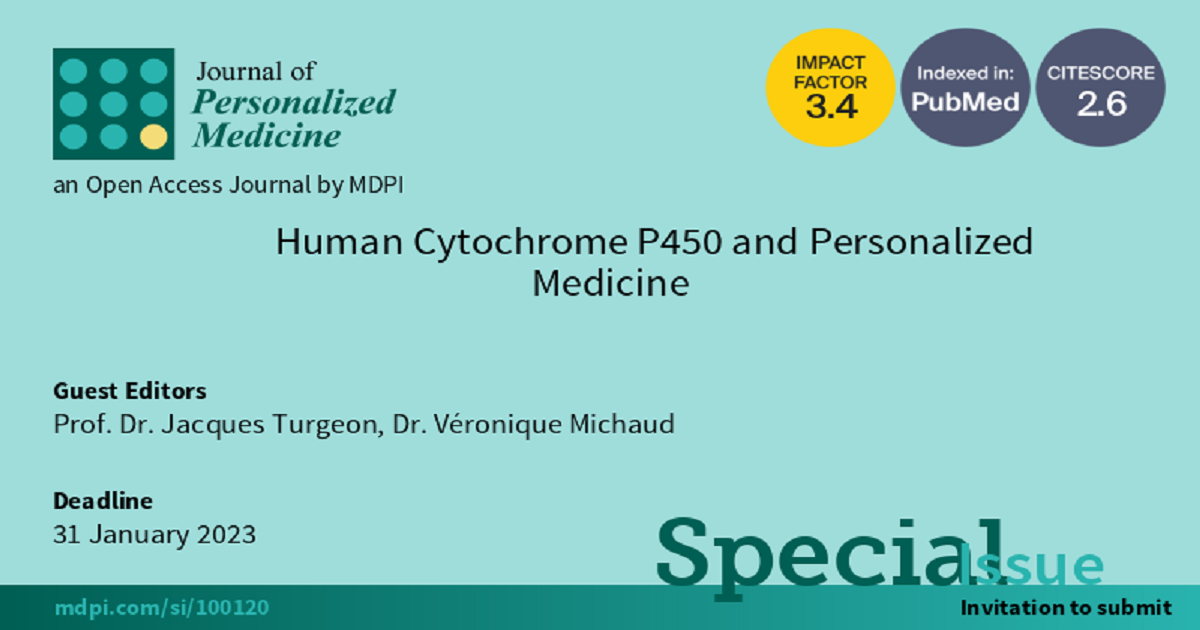Human Cytochrome P450 and Personalized Medicine
A special issue of Journal of Personalized Medicine (ISSN 2075-4426). This special issue belongs to the section "Omics/Informatics".
Deadline for manuscript submissions: closed (31 January 2023) | Viewed by 16249

Special Issue Editors
2. Faculty of Pharmacy, Université de Montréal, Montréal, QC H3C 3J7, Canada
Interests: phamacokinetics; pharmacogenetics; CYP450s; drug-induced long QT syndrome; clinical decision support systems drug–drug interactions
Special Issues, Collections and Topics in MDPI journals
2. Faculty of Pharmacy, Université de Montréal, Montréal, QC H3C 3J7, Canada
Interests: pharmacokinetics; pharmacogenomics; CYP450 drug-metabolizing enzymes; drug-drug interactions
Special Issue Information
Dear Colleagues,
It is our pleasure to invite you to contribute to a Special Issue of the Journal of Personalized Medicine (Impact Factor 4.945) entitled Human CYP450s and Personalized Medicine. We provide you with this invitation as we know you are an expert in the field, and believe that you could contribute a significant paper to this Issue, which can hopefully be published as a book. A regular peer-review process will be in place, and you will receive comments following your submission. As a high-impact journal, publication is therefore not guaranteed.
Our objective is to have several publications covering the impact of variant alleles of various CYP450 isoforms on the pharmacokinetics, pharmacodynamics and patient outcomes associated with numerous medications. Hopefully, we will have publications covering at least CYP1A2, CYP2B6, CYP2C9, CYP2C19, CYP2D6, CYP2E1, CYP2J2,CYP3A4/5 and CYP4F2. More than one paper for each isoform would be acceptable if they address conditions associated with different drugs. We urge you to let us know your topic of interest by submitting a title and a short abstract of the proposed publication (150 words). The deadline for submitting your work, either review or original article, is June 2022.
We hope to hear from you soon.
Prof. Dr. Jacques Turgeon
Dr. Véronique Michaud
Guest Editors
Manuscript Submission Information
Manuscripts should be submitted online at www.mdpi.com by registering and logging in to this website. Once you are registered, click here to go to the submission form. Manuscripts can be submitted until the deadline. All submissions that pass pre-check are peer-reviewed. Accepted papers will be published continuously in the journal (as soon as accepted) and will be listed together on the special issue website. Research articles, review articles as well as short communications are invited. For planned papers, a title and short abstract (about 100 words) can be sent to the Editorial Office for announcement on this website.
Submitted manuscripts should not have been published previously, nor be under consideration for publication elsewhere (except conference proceedings papers). All manuscripts are thoroughly refereed through a single-blind peer-review process. A guide for authors and other relevant information for submission of manuscripts is available on the Instructions for Authors page. Journal of Personalized Medicine is an international peer-reviewed open access monthly journal published by MDPI.
Please visit the Instructions for Authors page before submitting a manuscript. The Article Processing Charge (APC) for publication in this open access journal is 2600 CHF (Swiss Francs). Submitted papers should be well formatted and use good English. Authors may use MDPI's English editing service prior to publication or during author revisions.
Keywords
- CYP450s
- pharmacogenomics
- pharmacogenetics
- pharmacokinetics
- pharmacodynamics
- patient outcomes
- variant alleles
Benefits of Publishing in a Special Issue
- Ease of navigation: Grouping papers by topic helps scholars navigate broad scope journals more efficiently.
- Greater discoverability: Special Issues support the reach and impact of scientific research. Articles in Special Issues are more discoverable and cited more frequently.
- Expansion of research network: Special Issues facilitate connections among authors, fostering scientific collaborations.
- External promotion: Articles in Special Issues are often promoted through the journal's social media, increasing their visibility.
- Reprint: MDPI Books provides the opportunity to republish successful Special Issues in book format, both online and in print.
Further information on MDPI's Special Issue policies can be found here.






